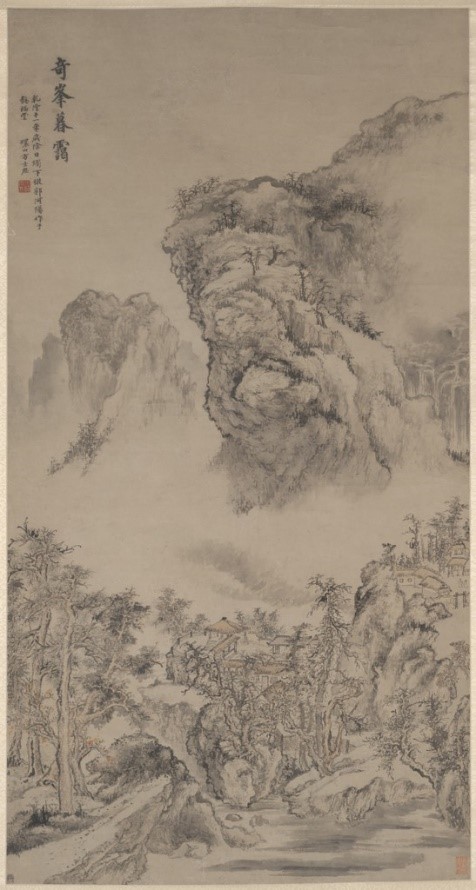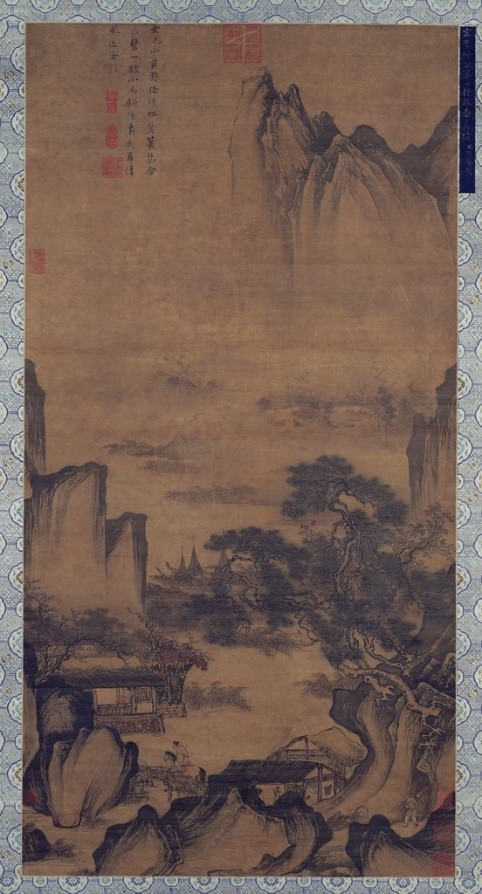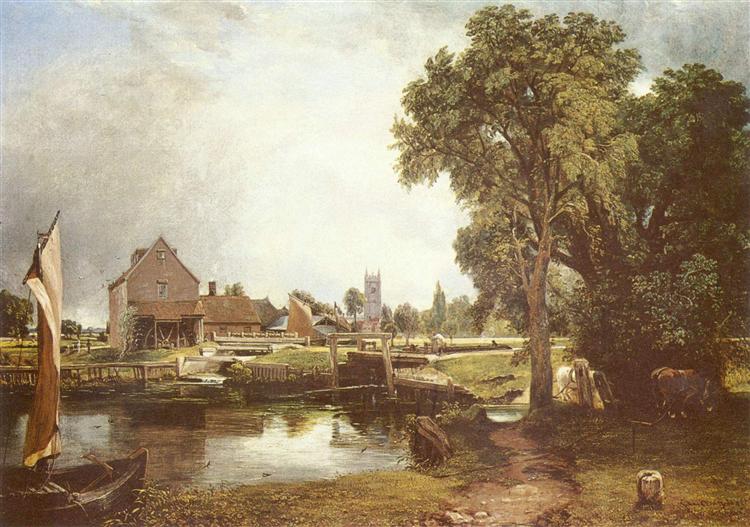Chinese Landscape Painting
What is your favorite Genre of painting? Do you like the sweeping vistas that open out in Landscape Painting? Variations on the landscape genre can be found around the world. However, this genre was rare until the form was pioneered by Li Ch’eng during the Song Dynasty. What do you think?
 |
 |
|
| Li, Ch’eng. (10th century). Solitary Temple Amid Clearing Peaks. Ink and color on silk. | Guo, Xi. (1072). Early Spring. Ink on silk scroll. | Tang, Yin. (ca. 1505-1510). Seeing Off a Guest on a Mountain Path. Ink and light colors on silk. |
These three works are clearly examples of a distinctive Genre. A glance at the range of dates suggests that this genre has persisted for many centuries, a sure sign that it is deeply rooted in Chinese culture. As individuals, we may or may not have much connection with Chinese culture. However, we can observe and reflect on what we see. We can recognize conventions that seemed to be share over the centuries:
- Elongated rectangular shape determined by the medium: silk or paper scrolls that can be unrolled or displayed vertically or horizontally
- Monochromatic colors: a narrow range of hues, again reflecting the primarily ink medium
- Conventional subjects: mountain, water, small scale human habitation, absent or minimized human figures
- Spatial zones: minimized foreground, looming middle distance, vanishing background
- Contrast: highly detailed sections opening into cloudy, vague mystery
Reflecting on our observations, we can begin to recognize Themes or patterns of meaning. Banal human life, minimized in mere traces of human presence, fades against spectacular natural vistas. Mountaintop elevation suggests, as it does in many cultures, spiritual enlightenment. Vertical composition lifts our eyes to the heavens, while void spaces seem to open out into the mysteries of infinity.
The Vista of the Immaterial–Mountain and Water
Now let’s see how an expert’s perspective can enhance our experience. In a 2017 reflection, Diep contrasts Chinese and Western approaches to landscape:
The closest term that I find suggesting landscape as the perceptual image in Chinese is fēng jıng 風景(wind + scene). Similar to the English word, the Chinese term implies a perceptual framework (i.e. the scene). Thus, in both languages, landscape is visual and anthropocentric. However, the Chinese landscape is the scenery of the wind and not of the land – it is the vista of the immaterial. Hence, the Chinese landscape is a paradox: It is a vision of the invisible. … A Chinese landscape painting, shān shuı huà 山水畫(mountain + water + picture), is literally a painting of the mountains and the water, both material and tangible features of nature (Diep, 2017 p. 79).
“The Chinese character for valley, gŭ 谷,” explains Diep (2017, p. 81), “is derived pictorially from a flowing River and not as the space between mountains.” Diep’s observations inform us that Chinese script consists of characters derived from pictograms. In Chinese culture, calligraphy forms the core skill leading to literacy, education, and art. Traditionally, Chinese painters began with calligraphy and developed their techniques using ink and paper. Paintings featuring ink on paper are, not surprisingly, often monochromatic (displaying a limited range of colors).
So, mountain and water. What is it about these conventional elements that inspire not only landscape paintings, but the essence that defines the whole idea of a valley? Here is Diep (2017):
Chinese landscape paintings are placed between the margins of heaven and earth. … The Chinese landscape is placed between the sky and the ground, tiān de jiān 天地間, a place that is simultaneously unknown and familiar. Thus, each element in nature is sacred. … Chinese philosophy accepts the uncertainty of nature and the uncertainty of human life. This uncertainty is what is divine and is the meaning of existence (Diep, 2017 p. 79).
Chinese paintings depict landscapes not merely to celebrate natural beauty, but also to evoke spiritual exaltation. These artists invite us to see portals into the infinite. Furthermore, they insert a reflective, enlightened human perspective directly into the scene:
Similar to Western landscape paintings, the human figure is infrequently found in Chinese landscape paintings. When people are depicted, they are often inconspicuous or diminutive compared to the landscape features. While European landscapes often depict peasants working or in leisure, the Chinese figure is usually of the pensive scholar (Diep, 2017 p. 79).
Chinese artists have worked in many media and genres. Some Chinese traditions of painting focused on depicting the aesthetic splendors of aristocratic life. But the landscape genre turns resolutely away from both the elegant luxuries of the elite and the squalor of poverty. Human perspective is reduced to temples of meditation compressed into a minimized foreground and, occasionally, tiny figures with scholarly or monkish aspirations.
Landscape paintings, then, affirm the highest ideals of Chinese culture. Buddhism offers enlightenment as the fruit of a pilgrimage out of the self and into the mystery of the transcendent. Confucianism and Taoism both call for the individual to rise above selfish indulgence and surrender to the principles of heaven.
OK. So how much of this did you “see”? Well, it depends on what we mean by “seeing.” Our discussion includes information that many students in an American class do not bring to their experience. And you may not be in the habit of analyzing your experience like this. Yet all of us can look closely. And the Themes we have discovered are all too human.
And, perhaps without having terms to explain things, you actually felt something when looking at the images. Beauty. Harmony. Even a suggestion of inspiration in the elevation of mountain and open space. Powerful images like these can bridge wide cultural gaps. The power of art lies in our dynamic experience itself. Analysis and background information can then open up new dimensions of the experience so we can return and discover new riches.
European Landscape painting: John Constable
Centuries later, European painters began to popularize the landscape painting. In the work of the English painter John Constable, we see the genre in a mature form:
 |
| John Constable. (1820). Dedham Lock & Mill. Oil on Canvas |
Notice how different is Constable’s orientation from that of the Chinese masters. While we may or may not find this view of bucolic England inspiring, the vision is settled in a time and place. There is little or no effort to inspire transcendent reflections beyond the boundaries of human experience. Constable places us securely in the English Suffolk. Even if we haven’t read Austen, the Brontë sisters, Hardy, and Eliot[1] we can probably “read” in the painting a good deal of Constable’s world. What ways of life are suggested by the elements of the scene, for example, the buildings? How does Constable compose (arrange) materials to imbue the painting with an air of serenity?
[1] Jane Austen, the Brontë sisters, Thomas Hardy, and George Eliot were 19th Century novelists whose social portraits have familiarized the world with English country life.
References
Constable, J. (1820). Dedham Lock and Mill. [Painting]. London: Victoria and Albert Museum. https://library-artstor-org.ezproxy.bethel.edu/asset/SCALA_ARCHIVES_1039930338.
Diep, V. T. (2017). The landscape of the void: Truth and magic in Chinese landscape painting. Journal of Visual Art Practice, 16(1), 77-86.
https://ezproxy.bethel.edu/login?url=https://search.ebscohost.com/login.aspx?direct=true&db=aph&AN=121504878&site=ehost-live&scope=site
Guo, X. (1072). Early spring [Painting]. Artstor https://library-artstor-org.ezproxy.bethel.edu/#/asset/ARTSTOR_103_41822003468954
Li, C. (10th century). Solitary temple amid clearing peaks [Painting]. Artstor https://library-artstor-org.ezproxy.bethel.edu/#/asset/ARTSTOR_103_41822000253706
Tang, Y. (ca. 1505-1510). Seeing off a guest on a mountain path [Painting]. Princeton University Art Museum, Princeton, NJ, United States. https://library-artstor-org.ezproxy.bethel.edu/#/asset/APRINCETONIG_10313684971
T’ang, Yin. (1516). Imitation of the Tang people. [Painting]. Retrieved from https://www.wikiart.org/en/tang-yin/-11516.
French term for a type, species, or class of composition with common conventions (“Genre”).
a picture representing an expanse of natural scenery, often featured in late medieval depictions of the months of the year and the four seasons, the backgrounds of Renaissance paintings, and in the 17th century work of Claude Lorrain and Dutch masters (Landscape painting).
established practices—whether in technique, style, structure, or subject-matter—commonly adopted in artistic works by customary agreement or precedent rather than by natural necessity (“Convention”).
patterns of thought, value, and reflection that are evoked in a work of art.
